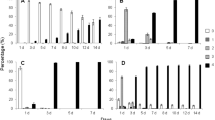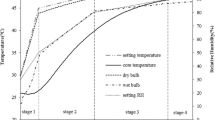Abstract
The insecticidal effect of low temperatures for the control of all life stages of two stored-product insects, Plodia interpunctella and Liposcelis bostrychophila, was evaluated under laboratory conditions. The temperatures tested were 0, − 5, − 10 and − 15 °C, and, at these temperatures, the insects were exposed for 2, 4 and 8 h and also for 1, 2, 3 and 7 days. Regarding P. interpunctella, the most cold-tolerant life stage was larvae, given that 2 days of exposure were needed for complete (100%) mortality at − 10 °C. Moreover, all larvae were dead at − 15 °C even after 2 h of exposure. Eggs of P. interpunctella were susceptible to cold, as mortality was complete after 7, 1 day, 2 and 2 h at 0, − 5, − 10 and − 15 °C, respectively. L. bostrychophila was by far less susceptible than P. interpunctella. For this species, adults were still alive even after 7 days at − 10 °C, while complete mortality was achieved only after 1 day at − 15 °C. Eggs of L. bostrychophila were the most cold-tolerant life stage, as survival was observed even after 3 days at − 15 °C. The results of the present study provide the first data set on which all life stages of P. interpunctella and L. bostrychophila are evaluated for their susceptibility to cold treatments in a standardized series of exposures and temperatures. These results are expected to further encourage the “real world” application of cold treatments for the disinfestation of durable stored-products.
Similar content being viewed by others
References
Abdelghany AY, Awadalla SS, Abdel-Baky NF, El-Syrafi HA, Fields PG (2010) Effect of high and low temperatures on the drugstore beetle (Coleoptera: Anobiidae). J Econ Entomol 103:1909–1914
Andreadis S, Athanassiou CG (2017) A review of insect cold hardiness and its potential in stored product insect control. Crop Prot 91:93–99
Andreadis SS, Spanoudis CG, Athanassiou CG, Savopoulou-Soultani M (2014) Factors influencing supercooling capacity of the koinobiont endoparasitoid Venturia canescens (Hymenoptera: Ichneumonidae). Pest Manag Sci 70:814–818
Arthur FH, Hartzer KL, Throne JE, Flinn PW (2015) Susceptibility of Tribolium castaneum (Coleoptera: Tenebrionidae) and Trogoderma inclusum (Coleoptera: Dermestidae) to cold temperatures. J Stored Prod Res 64:45–53
Arthur FH, Hartzer KL, Throne JE, Flinn PW (2017) Freezing for control of stored-product psocids. J Stored Prod Res 72:166–171
Athanassiou CG, Chiou A, Rumbos CI, Sotiroudas B, Sakka M, Nikolidaki EK, Panagopoulou EA, Kouvelas A, Katechaki E, Karathanos VT (2016) Effect of nitrogen in combination with elevated temperatures on insects, microbes and organoleptic characteristics of stored currants. J Pest Sci 90:557–567
Burks CS, Hagstrum DW (1999) Rapid cold hardening capacity in five species of coleopteran pests of stored grain. J Stored Prod Res 35:65–75
Cline DL (1970) Indian-meal moth egg hatch and subsequent larval survival after short exposures to low temperature. J Econ Entomol 63:1081–1083
Donahaye JE, Navarro S, Rindner M (1995) Low temperature as an alternative to fumigation for disinfecting dried fruit from three insect species. J Stored Prod Res 31:63–70
Eaton M, Kells SA (2011) Freeze mortality characteristics of the mold mite Tyrophagus putrescentiae, a significant pest of stored products. J Econ Entomol 104:1423–1429
Fields PG (1992) The control of stored-product insects and mites with extreme temperatures. J Stored Prod Res 28:89–118
Fields PG (2001) Control of insects in post-harvest: low temperature. In: Vincent C, Panneton B, Fleurat-Lessard F (eds) Physical control methods in plant protection. Springer, Paris, pp 95–107
Fields PG, Subramanyam B, Hulasare R (2012) Extreme temperatures. In: Hagstrum DW, Phillips TW, Cuperus G (eds) Stored product protection. Kansas State University, Kansas, pp 179–190
Flinn PW, Arthur FH, Throne JE, Friesen KS, Hartzer KL (2015) Cold temperature disinfestation of bagged flour. J Stored Prod Res 63:42–46
Hyun JN, Ryoo MI (2000) The influence of temperature on development of Plodia interpunctella (Lepidoptera: Pyralidae) on dried vegetable commodities. J Stored Prod Res 36:125–129
Imai T, Harada H (2006) Low-temperature as an alternative to fumigation to disinfest stored tobacco of the cigarette beetle, Lasioderma serricorne (F.) (Coleoptera: Anobiidae). Appl Entomol Zool 41:87–91
Johnson JA (2007) Survival of Indian meal Moth and Navel Orangeworm (Lepidoptera: Pyralidae) at low temperature. J Econ Entomol 100:1482–1488
Johnson JA, Wofford PL (1991) Effects of age on response of eggs of Indianmeal moth and Navel Orangeworm (Lepidoptera: Pyralidae) to subfreezing temperatures. J Econ Entomol 84:202–205
Johnson JA, Valero KA, Hannel MM, Gill RF (2000) Seasonal occurrence of postharvest dried fruit insects and their parasitoids in a culled fig warehouse. J Econ Entomol 93:1380–1390
Lewthwaite SE, Dentener PR, Alexander SM, Bennett KV, Rogers DJ, McDonald JH, Connolly PG (1998) High temperature and cold storage treatments to control Indian meal moth, Plodia interpunctella (Hübner). J Stored Prod Res 34:141–150
Limonta L, Locatelli DP (2015) Susceptibility of eggs of Idaea inquinata (Scop.) (Lepidoptera, Geometridae) to high and low temperatures. J Stored Prod Res 60:1–4
Mahroof R, Subramanyam B, Throne JE, Eustace D (2003a) Temperature and relative humidity profiles during heat treatment of mills and its efficacy against Tribolium castaneum (Herbst) life stages. J Stored Prod Res 39:555–569
Mahroof R, Subramanyam B, Throne JE, Menon A (2003b) Time-mortality relationships for Tribolium castaneum (Herbst) life stages exposed to elevated temperatures. J Econ Entomol 96:1345–1351
Mason LJ, Strait CA (1998) Stored product integrated pest management with extreme temperatures. In: Hallman GJ, Denlinger DL (eds) Temperature sensitivity in insects and application in integrated pest management. Westview Press, Boulder, pp 141–177
Nakakita H, Ikenaga H (1997) Action of low temperatures of Sitophilus zeamais Motschulsky and Sitophilus oryzae (L.) (Coleoptera: Curculionidae) in rice storage. J Stored Prod Res 33:31–38
Nayak MK, Collins PJ, Throne JE, Wang J (2014) Biology and management of psocids infesting stored products. Ann Rev Entomol 59:279–297
Sall J, Lehman A, Creighton L (2001) JMP start statistics. A guide to statistics and data analysis using JMP and JMP in software. Duxbury Press, Belmont, 491 pp
Sedlacek JD, Weston PA, Barney J (1996) Lepidoptera and psocoptera. In: Bh Subramanyam, Hagstrum DW (eds) Integrated management of insects in stored products. Marcel Dekker Inc., New York, pp 41–70
Smith LB (1970) Effects of cold-acclimation on supercooling and survival of the rusty grain beetle, Cryptolestes ferrugineus (Stephens) (Coleoptera: Cucujidae), at subzero temperatures. Can J Zool 48:853–858
Subramanyam Bh, Hagstrum DW (2000) Alternatives to pesticides in stored-product IPM. Kluwer Academic Publishers, Boston, p 437
Wilches DM, Laird RA, Floate KD, Fields PG (2016) A review of diapause and tolerance to extreme temperatures in Dermestids (Coleoptera). J Stored Prod Res 68:50–62
Williams AB, Murray A, Brown AC, Maretvesk D, Brady CA (1994) Effect of postharvest heat treatments on fruit quality, surface structure, and fungal disease in Valencia oranges. Austr J Exp Agric 34:1183–1190
Acknowledgements
Christos Athanassiou expresses his appreciation to the Fulbright Foundation for providing the Fulbright Visiting Scholar Grant that made this work possible. This paper reports the results of research only. Mention of trade names or commercial products in this publication is solely for the purpose of providing specific information and does not imply recommendation or endorsement by the University of Thessaly or the U.S. Department of Agriculture. The US Department of Agriculture is an equal opportunity provider and employer.
Author information
Authors and Affiliations
Corresponding author
Ethics declarations
Conflict of interest
All authors of this work declare that they have no conflicts of interest.
Studies involve human participants and/or animals
The research did not involve human participants and/or animals.
Ethical approval
This article does not contain any studies with human participants performed by any of the authors.
Additional information
Communicated by M. Traugott.
Rights and permissions
About this article
Cite this article
Athanassiou, C.G., Arthur, F.H. & Hartzer, K.L. Efficacy of low temperatures for the control of all life stages of Plodia interpunctella and Liposcelis bostrychophila. J Pest Sci 91, 1363–1369 (2018). https://doi.org/10.1007/s10340-018-0982-0
Received:
Revised:
Accepted:
Published:
Issue Date:
DOI: https://doi.org/10.1007/s10340-018-0982-0




